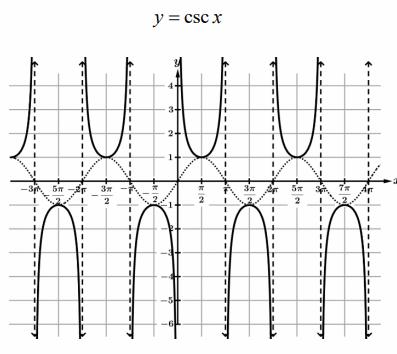HOW TO FIND VERTICAL ASYMPTOTE OF SEC CSC AND TAN FUNCTIONS
To find vertical asymptote of any rational function, we will equate the denominator to 0.
Graph of cosec x and its vertical asymptote :
cosec x = 1/sin x, where sin x ≠ 0
Cosec is the reciprocal of sine function.

The graph of y = csc x has vertical asymptotes where sin x x = 0
x = k𝜋, where k is an integer.
Graph of sec x and its vertical asymptote :
sec x = 1/cos x, where cos x ≠ 0
Secant is the reciprocal of cosine function.

The graph of y = sec x has vertical asymptotes where cos x = 0
Where k is an integer.
Graph of tan x and its vertical asymptote :
tan x = sin x/cos x, where cos x ≠ 0
The graph of y = tan x has vertical asymptotes where sin x x = 0
x = k𝜋, where k is an integer.

Problem 1 :
Let f(x) = 3 sec 2x, which of the following is the vertical asymptote on the graph f ?
a) x = π b) x = 3π/2 c) x = π/4 d) x = 0
Solution :
f(x) = 3 sec 2x
f(x) = 3 (1/cos 2x)
To find the vertical asymptote, we equate the denominator to 0.
cos 2x = 0
2x = cos -1(0)
2x = π/2, 3π/2, ......
x = π/4, 3π/4, ......
Accordingly the given option x = π/4 is the vertical asymptote for the function f(x).
Problem 2 :
Let g(x) = 4 - 2 csc (πx), which of the following is the vertical asymptote on the graph g ?
a) x = π/2 b) x = π c) x = 1/2 d) x = 1
Solution :
g(x) = 4 - 2 csc (πx)
g(x) = 4 - 2 (1/sin (πx))
To find the vertical asymptote, we equate the denominator to 0.
sin πx = 0
πx = sin -1(0)
πx = 0, π, 2π, ......
x = 0, 1, 2 , ......
Accordingly the given option x = 1 is the vertical asymptote for the function g(x).
Problem 3 :
Let k(x) = -5 cot (2πx), which of the following is the vertical asymptote on the graph k ?
a) x = 1/4 b) x = 1/2 c) x = π/2 d) x = 2π
Solution :
k(x) = -5 cot (2πx)
= -5(cos (2πx) / sin (2πx))
To find the vertical asymptote, we equate the denominator to 0.
sin 2 πx = 0
2πx = sin -1(0)
2πx = kπ
x = k/2
Where k is an integer.
Say k = 1, then x = 1/2
Say k = 2, then x = 2/2 ==> 1
Say k = 3, then x = 3/2 ==> 1.5
Accordingly the given option x = 1/2 is the vertical asymptote for the function k(x).
Problem 4 :
In order to graph y = (1/2) tan 2x, an interval containing one period is found by solving - π/2 < 2x < π/2.
An interval containing one period is two consecutive asymptotes occur at x = and x = .
Solution :
y = (1/2) tan 2x
- π/2 < 2x < π/2
Multiplying by 2, - π < x < π
So, one period of the given function y will lie in the interval (-π, π).
Vertical asymptote :
y = (1/2) tan 2x
y = sin 2x/2cos 2x
2 cos 2x = 0
cos 2x = 0
2x = cos-1(0)
2x = π/2 + k π
x = π/4 + (kπ/2)
|
Applying k = -2, we get x = π/4 + (-2π/2) x = π/4 - π x = -3π/4 |
Applying k = -1, we get x = π/4 + (-1π/2) x = π/4 - π/2 x = -π/4 |
|
Applying k = 0, we get x = π/4 + (0π/2) x = π/4 |
Applying k = 1, we get x = π/4 + (π/2) x = π/4 + π/2 x = 3π/4 |

So, consecutive vertical asymptotes are appearing at x = -3π/4 and x = π/4.
Problem 5 :
An interval containing one period of y = tan (x - π/2) is at x = . Thus, two consecutive asymptotes occur and x = and x =
Solution :
Since the given function is tangent function, its domain will be odd multiples of π/2
- π/2 < (x - π/2) < π/2
Adding π/2, we get
(-π/2) + (π/2) < x < π/2 + π/2
0 < x < π
So, one period of the given function y will lie in the interval (0, π).
Vertical asymptote :
y = tan (x - π/2)
y = sin (x - π/2) / cos (x - π/2)
cos (x - π/2) = 0
(x - π/2) = cos-1(0)
x - π/2 = π/2 + k π
x = (π/2 + π/2) + kπ
x = π + kπ
|
Applying k = -1, we get x = π - 1π x = 0 |
Applying k = 0, we get x = π + 0π x = π |
So, consecutive asymptotes will lie at x = 0 and x = π.

Recent Articles
-
Finding Range of Values Inequality Problems
May 21, 24 08:51 PM
Finding Range of Values Inequality Problems -
Solving Two Step Inequality Word Problems
May 21, 24 08:51 AM
Solving Two Step Inequality Word Problems -
Exponential Function Context and Data Modeling
May 20, 24 10:45 PM
Exponential Function Context and Data Modeling